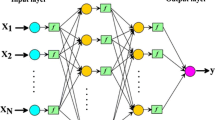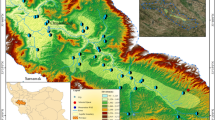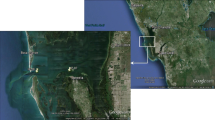Abstract
In present paper, wavelet analysis of total dissolved solid that monitored at Nazlu Chay (northwest of Iran), Tajan (north of Iran), Zayandeh Rud (central of Iran) and Helleh (south of Iran) basins with various climatic conditions, have been studied. Daubechies wavelet at suitable level (db4) has been calculated for TDS of each selected basins. The performance of artificial neural networks (ANN), two different adaptive-neurofuzzy inference system (ANFIS) including ANFIS with grid partition (ANFIS-GP) and ANFIS with subtractive clustering (ANFIS-SC), gene expression programming (GEP), wavelet-ANN, wavelet-ANFIS and wavelet-GEP in predicting TDS of mentioned basins were assessed over a period of 20 years at twelve different hydrometric stations. EC (μmhos/cm), Na (meq L−1) and Cl (meq L−1) parameters were selected (based on Pearson correlation) as input variables to forecast amount of TDS in four studied basins. To develop hybrid wavelet-AI models, the original observed data series was decomposed into sub-time series using Daubechies wavelets at suitable level for each basin. Based on the statistical criteria of correlation coefficient (R), root mean square error (RMSE) and mean absolute error (MAE), the hybrid wavelet-AI models performance were better than single AI models in all basins. A comparison was made between these artificial intelligence approaches which emphasized the superiority of wavelet-GEP over the other intelligent models with amount of RMSE 18.978, 6.774, 9.639 and 318.363 mg/l, in Nazlu Chay, Tajan, Zayandeh Rud and Helleh basins, respectively.












Similar content being viewed by others
References
Abonyi J, Andersen H, Nagy L, Szeifert F (1999) Inverse fuzzy-process-model based direct adaptive control. Math Comput Simul 51(1):119–132
Abudu S, King JP, Sheng Z (2012) Comparison of the performance of statistical models in forecasting monthly total dissolved solids in the Rio Grande. JAWRA J Am Water Resour Assoc 48(1):10–23
Adamowski J, Chan HF (2011) A wavelet neural network conjunction model for groundwater level forecasting. J Hydrol 407(1):28–40
Adamowski J, Sun K (2010) Development of a coupled wavelet transform and neural network method for flow forecasting of non-perennial rivers in semi-arid watersheds. J Hydrol 390(1):85–91
Alizadeh MJ, Kavianpour MR (2015) Development of wavelet-ANN models to predict water quality parameters in Hilo Bay, Pacific Ocean. Marine Pollution Bull 98(1):171–178
Antoine JP (1999) Wavelet analysis: a new tool in physics. In Wavelets in Physics Vol. 1, p 9
Antonopoulos VZ, Papamichail DM, Mitsiou KA (2001) Statistical and trend analysis of water quality and quantity data for the Strymon River in Greece. Hydrol Earth Syst Sci Dis 5(4):679–692
Apha A WPCF (American Public Health Association, American Water works Association, Water Pollution Control Federation) (1992) Standard methods for the examination of water and wastewater. Standard methods for the Examination of Water and Wastewater, 17
Aussem A, Campbell J, Murtagh F (1998) Wavelet-based feature extraction and decomposition strategies for financial forecasting. J Comput Intell Finance 6(2):5–12
Badrzadeh H, Sarukkalige R, Jayawardena AW (2013) Impact of multi-resolution analysis of artificial intelligence models inputs on multi-step ahead river flow forecasting. J Hydrol 507:75–85
Barzegar R, Adamowski J, Moghaddam AA (2016) Application of wavelet-artificial intelligence hybrid models for water quality prediction: a case study in Aji-Chay River, Iran. Stoch Environ Res Risk Assess 30(7):1797–1819
Bonami A, Soria F, Weiss G (1993) Band-limited wavelets. J Geometric Anal 3(6):543–578
Chang LC, Chang FJ (2001) Intelligent control for modelling of real-time reservoir operation. Hydrol Process 15(9):1621–1634
Chen D, Chen HW (2013) Using the Köppen classification to quantify climate variation and change: an example for 1901–2010. Environ Dev 6:69–79
Chenini I, Khemiri S (2009) Evaluation of ground water quality using multiple linear regression and structural equation modeling. Int J Environ Sci Technol 6(3):509–519
Chiu SL (1994) Fuzzy model identification based on cluster estimation. J Intell fuzzy Syst 2(3):267–278
Chu CK (1992) An introduction to wavelets. Academic, New York
Emamgholizadeh S, Kashi H, Marofpoor I, Zalaghi E (2014) Prediction of water quality parameters of Karoon River (Iran) by artificial intelligence-based models. Int J Environ Sci Technol 11(3):645–656
Etemad-Shahidi A, Afshar H, Alikia H, Moshfeghi H (2009) Total dissolved solid modeling; Karkheh reservoir case example. Int J Environ Res 3(4):671–680
Ferreira C (2006) Gene expression programming: mathematical modeling by an artificial intelligence (Vol. 21). Springer, Berlin
Fijani E, Nadiri AA, Moghaddam AA, Tsai FTC, Dixon B (2013) Optimization of DRASTIC method by supervised committee machine artificial intelligence to assess groundwater vulnerability for Maragheh-Bonab plain aquifer, Iran. J Hydrol 503:89–100
Ghavidel SZZ, Montaseri M (2014) Application of different data-driven methods for the prediction of total dissolved solids in the Zarinehroud basin. Stoch Environ Res Risk Assess 28(8):2101–2118
Gocic M, Trajkovic S (2013) Trend analysis of water quality parameters for the Nisava river. Facta Univ-Ser: Archit Civil Eng 11(3):199–210
Hagan MT, Menhaj MB (1994) Training feedforward networks with the Marquardt algorithm. IEEE Trans Neural Netw 5(6):989–993
Ham FM, Kostanic I (2001) Fundamental neurocomputing concepts. Principles of Neurocomputing for Science and Engineering. Arnold Publishers, London, pp 24–91
Haykin S (1998) Neural networks a comprehensive foundation, 2nd edn. Prentice-Hall, Upper Saddle River, pp 26–32
Jang JSR, Sun CT, Mizutani E (1997) Neuro-fuzzy and soft computing: a computational approach to learning and machine intelligence. Prentice Hall, New Jersey
Karunanithi N, Grenney WJ, Whitley D, Bovee K (1994) Neural networks for river flow prediction. J Comput Civil Eng 8(2):201–220
Kennedy EP, Condon M, Dowling J (2003) Torque-ripple minimisation in switched reluctance motors using a neuro-fuzzy control strategy. In: Modelling and Simulation (pp 106–109)
Kim TW, Valdés JB (2003) Nonlinear model for drought forecasting based on a conjunction of wavelet transforms and neural networks. J Hydrol Eng 8(6):319–328
Kisi O, Shiri J (2011) Precipitation forecasting using wavelet-genetic programming and wavelet-neuro-fuzzy conjunction models. Water Resour Manage 25(13):3135–3152
Kisi O, Nia AM, Gosheh MG, Tajabadi MRJ, Ahmadi A (2012) Intermittent streamflow forecasting by using several data driven techniques. Water Resour Manage 26(2):457–474
Köppen W (1936) Handbuch der Klimatologie. In: Köppen W and Geiger G (eds) 1. C. Gebr, Borntraeger, (pp 1–44)
Kottek M, Grieser J, Beck C, Rudolf B, Rubel F (2006) World map of the Köppen-Geiger climate classification updated. Meteorol Z 15(3):259–263
Krauss G, Kindangen JI, Depecker P (1997) Using artificial neural networks to predict interior velocity coefficients. Build Environ 32(4):295–303
Kumar S, Kumar A, Kumar R, Pathak JK, Alam M (2014) Spectral analysis of biochemical oxygen demand in river water: an analytical approach of discrete wavelet transform. Am J Math Stat 4(2):107–112
Leščešen I, Pantelić M, Dolinaj D, Stojanović V, Milošević D (2015) Statistical analysis of water quality parameters of the Drina River (West Serbia), 2004–11. Pol J Environ Stud 24(2):555–661
Mamdani EH, Assilian S (1975) An experiment in linguistic synthesis with a fuzzy logic controller. Int J Man Mach Stud 7(1):1–13
Mehr AD, Kahya E, Bagheri F, Deliktas E (2014) Successive-station monthly streamflow prediction using neuro-wavelet technique. Earth Sci Inf 7(4):217–229
Mishra AK, Desai VR (2006) Drought forecasting using feed-forward recursive neural network. Ecol Model 198(1):127–138
Moosavi V, Vafakhah M, Shirmohammadi B, Behnia N (2013a) A wavelet-ANFIS hybrid model for groundwater level forecasting for different prediction periods. Water Resour Manage 27(5):1301–1321
Moosavi V, Vafakhah M, Shirmohammadi B, Ranjbar M (2013b) Optimization of wavelet-ANFIS and wavelet-ANN hybrid models by Taguchi method for groundwater level forecasting. Arab J Sci Eng 39:1785–1796
Mousavi M, Kiani S, Lotfi S, Naeemi N, Honarmand M (2008) Transient and spatial modeling and simulation of polybrominated diphenyl ethers reaction and transport in air, water and soil. Int J Environ Sci Technol 5(3):323–330
Najah AA, El-Shafie A, Karim OA, Jaafar O (2012) Water quality prediction model utilizing integrated wavelet-ANFIS model with cross-validation. Neural Comput Appl 21(5):833–841
Nourani V, Alami MT, Aminfar MH (2009) A combined neural-wavelet model for prediction of Ligvanchai watershed precipitation. Eng Appl Artif Intell 22(3):466–472
Nourani V, Kisi Ö, Komasi M (2011) Two hybrid artificial intelligence approaches for modeling rainfall–runoff process. J Hydrol 402(1):41–59
Nourani V, Baghanam AH, Adamowski J, Gebremichael M (2013) Using self-organizing maps and wavelet transforms for space–time pre-processing of satellite precipitation and runoff data in neural network based rainfall–runoff modeling. J Hydrol 476:228–243
Nourani V, Baghanam AH, Adamowski J, Kisi O (2014a) Applications of hybrid wavelet–Artificial Intelligence models in hydrology: a review. J Hydrol 514:358–377
Nourani V, Baghanam AH, Rahimi AY, Nejad FH (2014b) Evaluation of wavelet-based de-noising approach in hydrological models linked to artificial neural networks. In: Computational intelligence techniques in earth and environmental sciences. Springer, Netherlands, pp 209–241
Özger M, Kabataş MB (2015) Sediment load prediction by combined fuzzy logic-wavelet method. J Hydroinf 17(6):930–942
Parmar KS, Bhardwaj R (2013) Wavelet and statistical analysis of river water quality parameters. Appl Math Comput 219(20):10172–10182
Parmar KS, Bhardwaj R (2015) River water prediction modeling using neural networks, fuzzy and wavelet coupled model. Water Resour Manage 29(1):17–33
Partal T, Cigizoglu HK (2009) Prediction of daily precipitation using wavelet—neural networks. Hydrol Sci J 54(2):234–246
Partal T, Kişi Ö (2007) Wavelet and neuro-fuzzy conjunction model for precipitation forecasting. J Hydrol 342(1):199–212
Rahimikhoob A (2010) Estimation of evapotranspiration based on only air temperature data using artificial neural networks for a subtropical climate in Iran. Theoret Appl Climatol 101(1–2):83–91
Rajaee T, Mirbagheri SA, Zounemat-Kermani M, Nourani V (2009) Daily suspended sediment concentration simulation using ANN and neuro-fuzzy models. Sci Total Environ 407(17):4916–4927
Ramana RV, Krishna B, Kumar SR, Pandey NG (2013) Monthly rainfall prediction using wavelet neural network analysis. Water Resour Manage 27(10):3697–3711
Ravansalar M, Rajaee T (2015) Evaluation of wavelet performance via an ANN-based electrical conductivity prediction model. Environ Monit Assess 187(6):366
Ren L, Xiang XY, Ni JJ (2011) Forecast modeling of monthly runoff with adaptive neural fuzzy inference system and wavelet analysis. J Hydrol Eng 18(9):1133–1139
Samhouri M, Abu-Ghoush M, Yaseen E, Herald T (2009) Fuzzy clustering-based modeling of surface interactions and emulsions of selected whey protein concentrate combined to ι-carrageenan and gum arabic solutions. J Food Eng 91(1):10–17
Sanikhani H, Kisi O (2012) River flow estimation and forecasting by using two different adaptive neuro-fuzzy approaches. Water Resour Manage 26(6):1715–1729
Sanikhani H, Kisi O, Nikpour MR, Dinpashoh Y (2012) Estimation of daily pan evaporation using two different adaptive neuro-fuzzy computing techniques. Water Resour Manage 26(15):4347–4365
Shankar BU, Meher SK, Ghosh A (2011) Wavelet-fuzzy hybridization: feature-extraction and land-cover classification of remote sensing images. Appl Soft Comput 11(3):2999–3011
Shekarrizfard M, Karimi-Jashni A, Hadad K (2012) Wavelet transform-based artificial neural networks (WT-ANN) in PM10 pollution level estimation, based on circular variables. Environ Sci Pollut Res 19(1):256–268
Shiri J, Kişi Ö (2011) Estimation of daily suspended sediment load by using wavelet conjunction models. J Hydrol Eng 17(9):986–1000
Shiri J, Nazemi AH, Sadraddini AA, Landeras G, Kisi O, Fard AF, Marti P (2013) Global cross-station assessment of neuro-fuzzy models for estimating daily reference evapotranspiration. J Hydrol 480:46–57
Shirmohammadi B, Vafakhah M, Moosavi V, Moghaddamnia A (2013) Application of several data-driven techniques for predicting groundwater level. Water Resour Manage 27(2):419–432
Singh KP, Malik A, Basant N, Saxena P (2007) Multi-way partial least squares modeling of water quality data. Anal Chim Acta 584(2):385–396
Singh KP, Basant A, Malik A, Jain G (2009) Artificial neural network modeling of the river water quality—a case study. Ecol Model 220(6):888–895
Smeti EM, Golfinopoulos SK (2016) Characterization of the quality of a surface water resource by multivariate statistical analysis. Anal Lett 49(7):1032–1039
Takagi T, Sugeno M (1985) Fuzzy identification of systems and its applications to modeling and control. IEEE Trans Syst, Man, Cybern 1:116–132
Talei A, Chua LH (2012) Influence of lag time on event-based rainfall–runoff modeling using the data driven approach. J Hydrol 438:223–233
Tiwari MK, Chatterjee C (2011) A new wavelet–bootstrap–ANN hybrid model for daily discharge forecasting. J Hydroinf 13(3):500–519
Tsukamoto Y (1979) An approach to fuzzy reasoning method. Adv Fuzzy Set Theory and Appl 137:149
Wang Y, Wang P, Bai Y, Tian Z, Li J, Shao X, Li BL (2013a) Assessment of surface water quality via multivariate statistical techniques: a case study of the Songhua River Harbin region, China. J Hydro-Environ Res 7(1):30–40
Wang F, Wang X, Chen B, Zhao Y, Yang Z (2013b) Chlorophyll a simulation in a Lake Ecosystem using a model with wavelet analysis and Artificial Neural Network. Environ Manage 51(5):1044–1054
Wei M, Bai B, Sung AH, Liu Q, Wang J, Cather ME (2007) Predicting injection profiles using ANFIS. Inf Sci 177(20):4445–4461
Yager RR, Filev DP (1994) Approximate clustering via the mountain method. IEEE Trans Syst, Man, Cybern 24(8):1279–1284
Author information
Authors and Affiliations
Corresponding author
Rights and permissions
About this article
Cite this article
Montaseri, M., Zaman Zad Ghavidel, S. & Sanikhani, H. Water quality variations in different climates of Iran: toward modeling total dissolved solid using soft computing techniques. Stoch Environ Res Risk Assess 32, 2253–2273 (2018). https://doi.org/10.1007/s00477-018-1554-9
Published:
Issue Date:
DOI: https://doi.org/10.1007/s00477-018-1554-9




